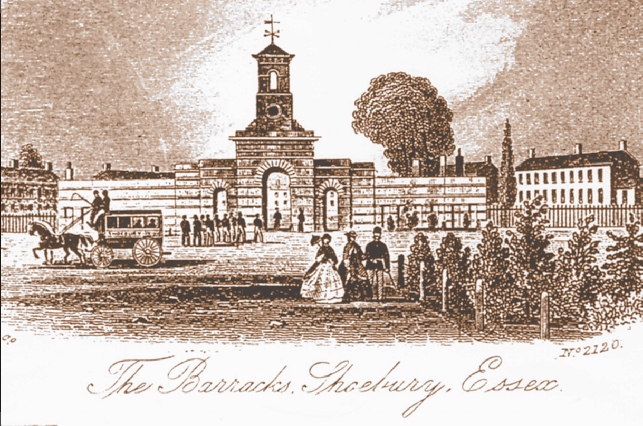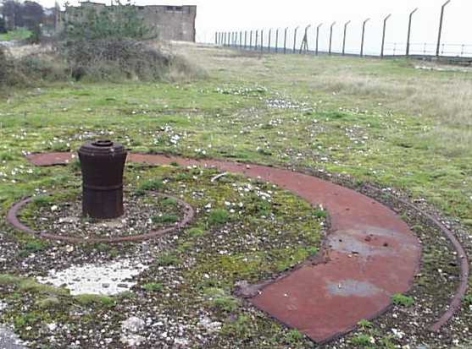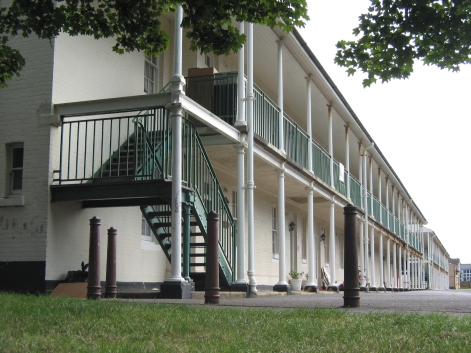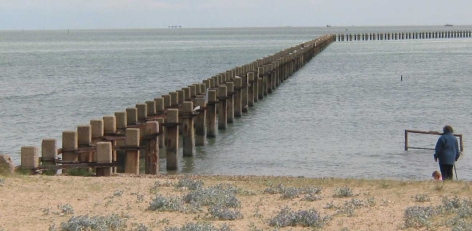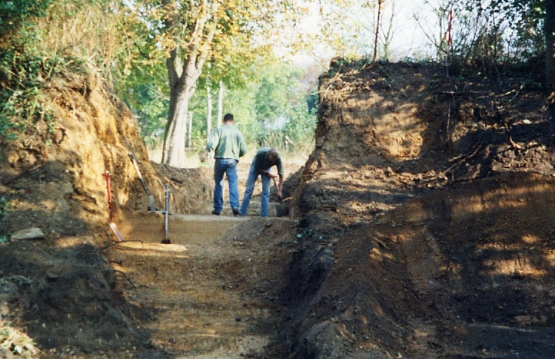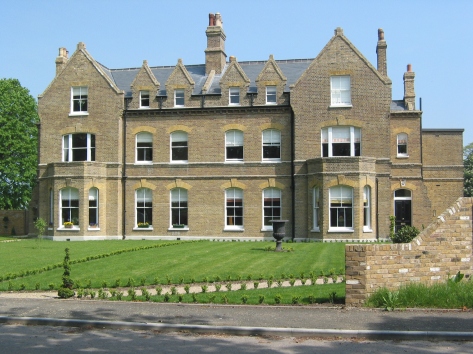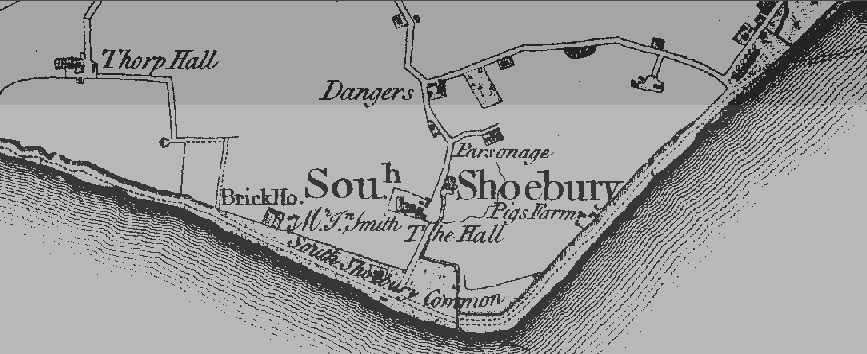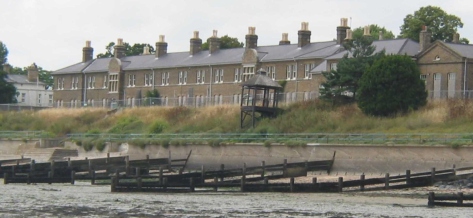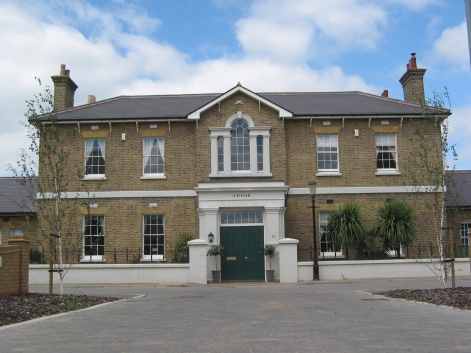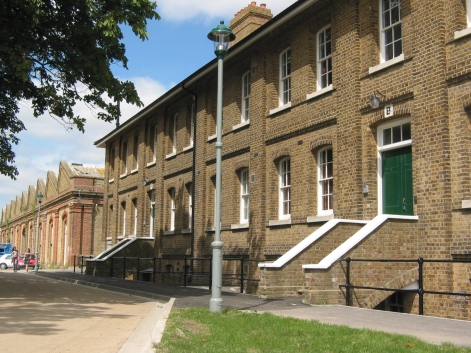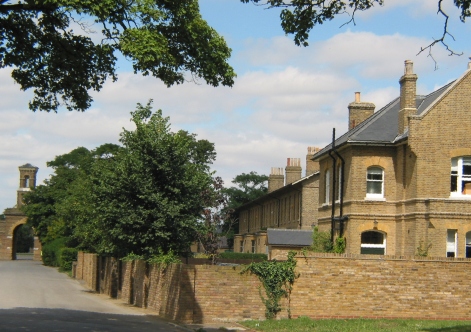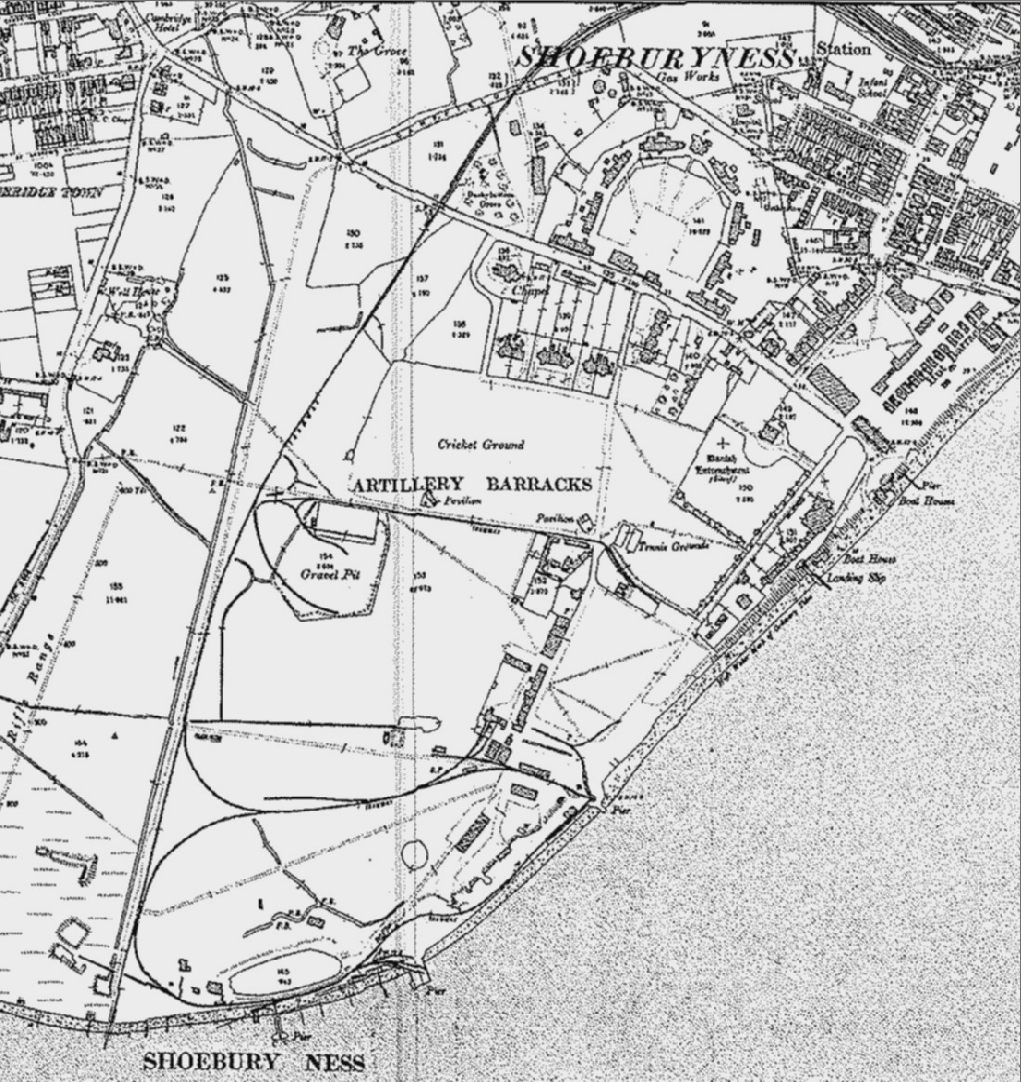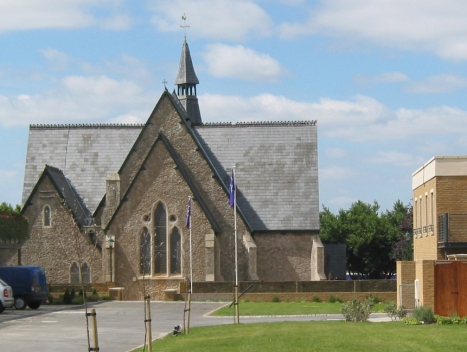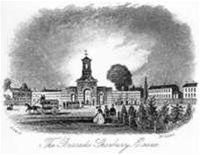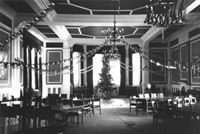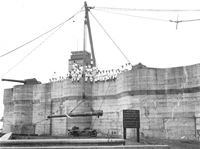An estate surrounded by history
From 1865 the Station was used by the National Artillery Association for its annual artillery contests. 'Campfield' to the rear of the Barracks was included in the Station as a camp site for well over 1000 military competitors each year. Campfield Road was constructed as military road within the Station in 1886, and Sergeants' Married Quarters (14) (the 'Birdcage' now Ash Court & Beech Lodge, Rosewood Lane) were built on part of Campfield. Sergeants’ Married Quarters. nt
Artillery training, experimental use of guns, rockets and explosives, and the testing of armour and defensive casements grew up to the end of the century. Experimental casements built in 1872-3 were adapted into the Light Quick Firing Battery (15) twenty years later. The Heavy Quick Firing Battery (16) (1898) also adapted a previous structure.
Heavy Quick Firing Battery, 1914.
The Garrison's development had a profound impact on Shoebury, transforming it from a scattered rural community into a Garrison town. Development around the East Gate in the High Street was small scale until the arrival of the railway in 1884. 'Cambridge Town' around the West Gate created slum conditions with unmade roads, no sewers and no piped water. Shoebury Urban District Council was set up in 1895, in part to improve conditions. Intensive activity during the World Wars was separated by inter-war decline and the final separation of experimentation and testing from the Garrison. It also saw a reduction in the Garrison's size with Campfield Road and part of Chapel Road becoming public roads.
Rearmament in 1936 led to new defences including air raid shelters, command posts, new batteries, and searchlight emplacements. Surviving features are identified in the Council's 'Survey of World War II Defences', 2001. Visible from the Garrison are other military features of this period: the Cold War Defence Boom at East Beach, which replaced the 193940 timber boom; the wreck of a section of Mulberry Harbour off Thorpe Bay, built for the D Day landings in France; World War II Forts in the mouth of the Estuary to the east.
HERITAGE OPEN DAYS SHOEBURY GARRISON
The Clock Tower, built in 1856.
Shoebury Garrison is a unique area of national importance. Its
history, archaeology and historic buildings, and its unique setting overlooking the mouth of the Thames Estuary with adjacent beaches, parkland and nature reserves make it a fascinating area to explore. Public access to much of the Garrison is now possible following the ending of its military use. This Heritage Open Days leaflet will help you discover something of its history...
Cold War Defense Boom, with World War II Forts on the horizon.
Southend-on-Sea Borough Council
Archaeological Evidence
Post-war , the Garrison
History provided by Southend.gov
The History of Shoebury Garrison Shoebury Garrison is a unique area of national importance. Its history, archaeology and historic buildings, and its unique setting overlooking the mouth of the Thames Estuary with adjacent beaches, parkland and nature reserves make it a fascinating area to explore. Located on slightly raised land at the mouth of the Thames estuary, Shoebury has had strategic importance since prehistoric times. Ramparts which may have formed a semi-circle, open to the sea, protected an Iron Age settlement. Parts of the ramparts survive, together with evidence of human activity within them, including round houses, ditches and post holes. The Romans also built a fortified settlement at Shoebury. It was attacked by the British in AD50 but is thought to have survived in some form into the 4th century. Its exact position is unknown but a Roman building may have existed near the former Officer’s Mess. In the 6th century Saxon invaders re-established a settlement at Shoebury which later became a base for the Danes who sought to overrun the Saxon kingdom. The Danes may have used the Iron Age ramparts as a fortification but no evidence has been found to verify this. Through the medieval and post medieval periods the area remained isolated and rural. During the 1840s Royal Artillery artillery ranges near Woolwich became increasingly difficult to use owing to their proximity to the heavily used shipping route along the Thames. Shoeburyness was chosen for a new testing and practice Station. It offered an isolated site, extensive land and foreshore for firing, easy access by river from Woolwich and a coastal location for the transport of heavy artillery. Following five years of temporary summer use, development as a permanent Station started in 1854 in response to the Crimean War. The War led to a rapid expansion in testing and practice firing for the army and navy. With the adoption of rifled guns* and the commissioning of armoured ships, a ‘battle’ developed to find more powerful guns on the one hand and more effective armour and coastal defences on the other. This battle was ‘largely fought on the Marshes at Shoeburyness …..’ (from ‘Guns & Gunners at Shoeburyness’, 1999, Tony Hill) * rifled guns rotate bullets and shells as they are fired to give greater accuracy, distance and rate of fire. Buildings from this early period include: • • •
•
Commandant’s House, Mess Road (1854), Beach House, Mess Road, for the Station’s second in command (c1856). The Officers’ Mess and Servant’s Quarters, Mess Road, 1852, built around a former coastguard station, part of which is still visible. The Mess was extended and altered several times over the next 50 years. Garrison Hospital, Hospital Road (1856) - possibly the most advanced barrack hospital at that time with separate isolation, fever, casualty and
• •
general wards and an internal kitchen. Florence Nightingale may have inspected it shortly after it opened. Single-storey Sergeants’ Quarters are attached to the Hospital. Two Powder Magazines, Magazine Road (1851 & c1856). And Chapel Road was built (c1857) to give the Station better road access from Ness Road.
The Crimean War also highlighted the need for a dedicated School of Gunnery for the Royal Artillery to standardise training with the new weaponry. The new School was established at Shoebury in 1859, in a greatly enlarged area of 200 acres, extending to Ness Road. New buildings included: • •
• • • • • •
Garrison Church, Chapel Road (1866). Horseshoe Barracks, (1859-1862). Buildings in a formal ‘horseshoe’ layout enclosed the parade ground. They were barrack blocks with separate cook houses to the rear, a Sergeants’ Mess, Garrison School, and an arched gateway and clock tower flanked by the guardroom, cells and offices. Their unique design showed reformed standards of military accommodation. Gunnery Drill Shed, Chapel Road (1859). Long Course Officers’ Quarters (the ‘Stack’), Chapel Road (1871). Married Officers’ Quarters, The Terrace, overlooking the cricket square (1866-1871), included the surgeon’s house. Single Officers’ Quarters, 1-7 Warrior Square Road (1860 and c1870). Clerk of Works Quarters, 9 Warrior Square Road (c1861) Carriage & Wagon Shed, Warrior Square Road (c1860)
Note the way the Garrison’s buildings reflect the military hierarchy in their designs – the grander the use or the user then the grander the design and accommodation. By the early 1870s, the Station had been substantially completed. From 1865 the Station was used by the National Artillery Association for its annual artillery contests. ‘Campfield’ to the rear of the Barracks was included in the Station as a camp site for well over 1000 military competitors each year. Campfield Road was constructed as a military road within the Station in 1886, and Sergeants’ Married Quarters (the ‘Birdcage’ - now Ash Court & Beech Lodge, Rosewood Lane) were built on part of Campfield. Artillery training, experimental use of guns, rockets and explosives, and the testing of armour and defensive casements grew up to the end of the century. Experimental casements built in 1872-3 were adapted into the Light Quick Firing Battery twenty years later. The Heavy Quick Firing Battery (1898) also adapted a previous structure. Although few of the structures now remain, they have left much archaeological evidence, especially close to the sea wall. During this period, the Station played a central role in artillery development such as rifled barrels, breach loading, Hale’s war rockets, shrapnel, quick firing weapons and the replacement of gunpowder with cordite. Notably, William Armstrong, one of the main armaments innovators and manufacturers, tested many of his weapons at Shoebury.
The inherent danger of the Station’s work was shown when an accidental explosion in 1885 killed seven personnel. Public subscription in memory of those killed paid for a new Married Soldier's Hospital, Campfield Road (now a public house). A memorial is also on the site of the explosion. Improvement of weaponry led once more to the need for longer and more isolated firing ranges. From 1889 experimentation and testing began to be transferred to the New Ranges, north of East Beach, and the Garrison increasingly specialised in training. The Garrison’s development had a profound impact on Shoebury, transforming it from a scattered rural community into a Garrison town. Development around the East Gate in the High Street was small scale until the arrival of the railway in 1884. ‘Cambridge Town’ around the West Gate created slum conditions with unmade roads, no sewers and no piped water. Shoebury Urban District Council was set up in 1895, in part to improve conditions. Intensive activity during the World Wars was separated by inter-war decline and the final separation of experimentation and testing from the Garrison. It also saw a reduction in the Garrison’s size with Campfield Road and part of Chapel Road becoming public roads. Rearmament in 1936 led to new defences including air raid shelters, command posts, new batteries, and searchlight emplacements. Surviving features are identified in the Council’s ‘Survey of World War II Defences’, 2001. Visible from the Garrison are other military features of this period: the Cold War Defence Boom at East Beach, which replaced the 1939-40 timber boom; the wreck of a section of Mulberry Harbour off Thorpe Bay, built for the D-Day landings in France; World War II Forts in the mouth of the Estuary to the east. Post-war, the Garrison continued to house residential artillery units until 1976 when the Garrison HQ was disbanded. The site was eventually sold in 2000 for development in accordance with an agreed planning brief. The Garrison’s military heritage is now nationally recognised and protected. Many of its surviving buildings are listed buildings. And much of the area within the pre-historic ramparts, as well as the Cold War Defence Boom and the Mulberry Harbour, are protected as scheduled ancient monuments. A large part of the Garrison is also a conservation area. Development at the Garrison is bringing the whole area back to life. New buildings mostly reflect architectural themes of the historic buildings without slavishly copying past designs. And new open spaces, views, focal points and parkland are being created for the public along with new access to beaches and seawall. It really is a unique area to treasure.




